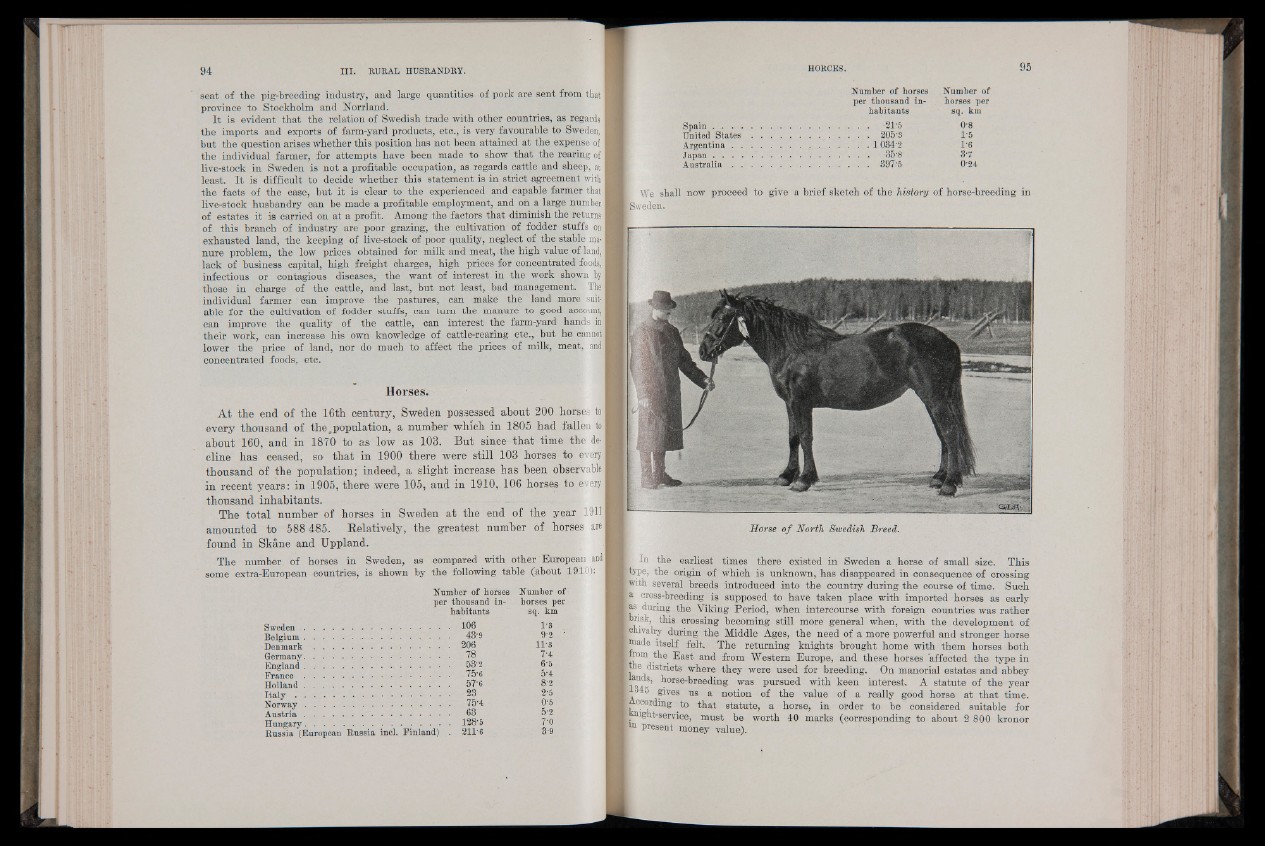
seat of the pig-breeding industry, and large quantities of pork are sent from that I
province to Stockholm and 'X orrland.
It is evident that the relation of Swedish trade with other countries, as regards
the imports and exports of farm-yard products, etc., is very favourable to Sweden,
but the question arises whether this position has not been attained at the expense of
the individual farmer, for attempts have been made to show that the rearing of ]
live-stock in Sweden is not a profitable occupation, as regards cattle and sheep, at
least. It is difficult to decide whether this statement is in strict agreement with
the facts of the case, but it is clear to the experienced and capable farmer that;
live-stock husbandry can be made a profitable employment, and oh a large numberi
of estates it is carried on at a profit. Among the factors that diminish the returns
of this branch of industry are poor grazing, the cultivation of fodder stuffs o#|
exhausted land, the keeping of live-stock of poor quality, neglect of the stable ma-!
nure problem, the low prices obtained for milk and meat, the high value of land, '
lack of business capital, high freight charges, high prices for concentrated foods,]
infectious or contagious diseases, the want of interest in the work shown by a
those in charge of the cattle, and last, but not least, bad management. The!
individual farmer can improve the pastures, can make the land more sum
able for the cultivation of fodder stuffs, can turn the manure to good account,;
can improve the quality of the cattle, can interest- the farm-yard hands in
their work, can increase his own knowledge of cattle-rearing etc., but he cannot!
lower the price of land, nor do much to affect the prices of milk, meat, andj
concentrated foods, etc.
Horses.
At the end of the 16th century, Sweden possessed about 200 horses to
every thousand of the,population, a number which in 1805 had fallen to!
about 160, and in 1870 to as low as 103. But since that time the decline
has ceased, so that in 1900 there were still 103 honses to f every
thousand of the population; indeed, a slight increase has been observable
in recent years: in 1905, there were 105, and in 1910, 106 horses to|every
thousand inhabitants.
The total number of horses in Sweden at the end of the year 1911,
amounted to 588 485. Relatively, the greatest number of horses are
found in Skane and Uppland.
The number of horses in Sweden, as compared with other European and
some extra-European countries, is shown by the following table (about 1910): J
Number of horses Number of
per thousand in- horses per
habitants sq. km
Sw ed en ........................................................... 106 1*3
Belgium........................................................... 43’9 9*2
D e nm a rk ....................................................... 206 11*3
Germany. .................................................... 78 7*4
England........................................................... 53*2 6*5
F r a n c e ........................................................... 75*6 5*4
Holland........................................................... 57*6 8*2
I t a l y ........................................................... .... 23 2*5
N o rw ay ........................................................... 75*4 0*5
A u s tr ia ........................................................... 63 5*2
Hungary........................................................... 128*5 7*0
Russia (European Russia incl. Finland) . 211*6 3*9
Number of horses Number of
per thousand in- horses per
habitants sq. km
Spain . ............................................................ -21*5 0*8
United S t a t e s ........................... 205*3 1*5
Argentina................................ 1 034*2 1*6
Japan ............................................ -35*8 3*7
A u s tr a lia ........................................................ 397*5 0*24
I We shall now proceed to give a brief sketch of the history of horse-breeding in
feweden.
Horse o f North Swedish Breed.
k In the earliest times there existed in Sweden a horse of small size. This
gype, the origin of which is unknown, has disappeared in consequence of crossing
jwith several breeds introduced into the country during the course of time. Such
a cross-breeding is supposed to have taken place with imported horses as early
fas during the Viking Period, when intercourse with foreign countries was rather
Brisk, this crossing becoming still more general when, with the development of
imivalry during the Middle Ages, the need of a more powerful and stronger horse
(nade itself felt. The returning knights brought home with them horses both
pom the East and from Western Europe, and these horses 'affected the type in
pbe districts where they were used for breeding. On manorial estates and abbey
I s a 8’ korse-breeding was pursued with keen interest. A statute of the year
L gives us a notion of the value of a really good horse at that time,
^ccording to that statute, a horse, in order to be considered suitable for
service, must be worth 40 marks (corresponding to (might about 2 800 kronor I“ Present money value).